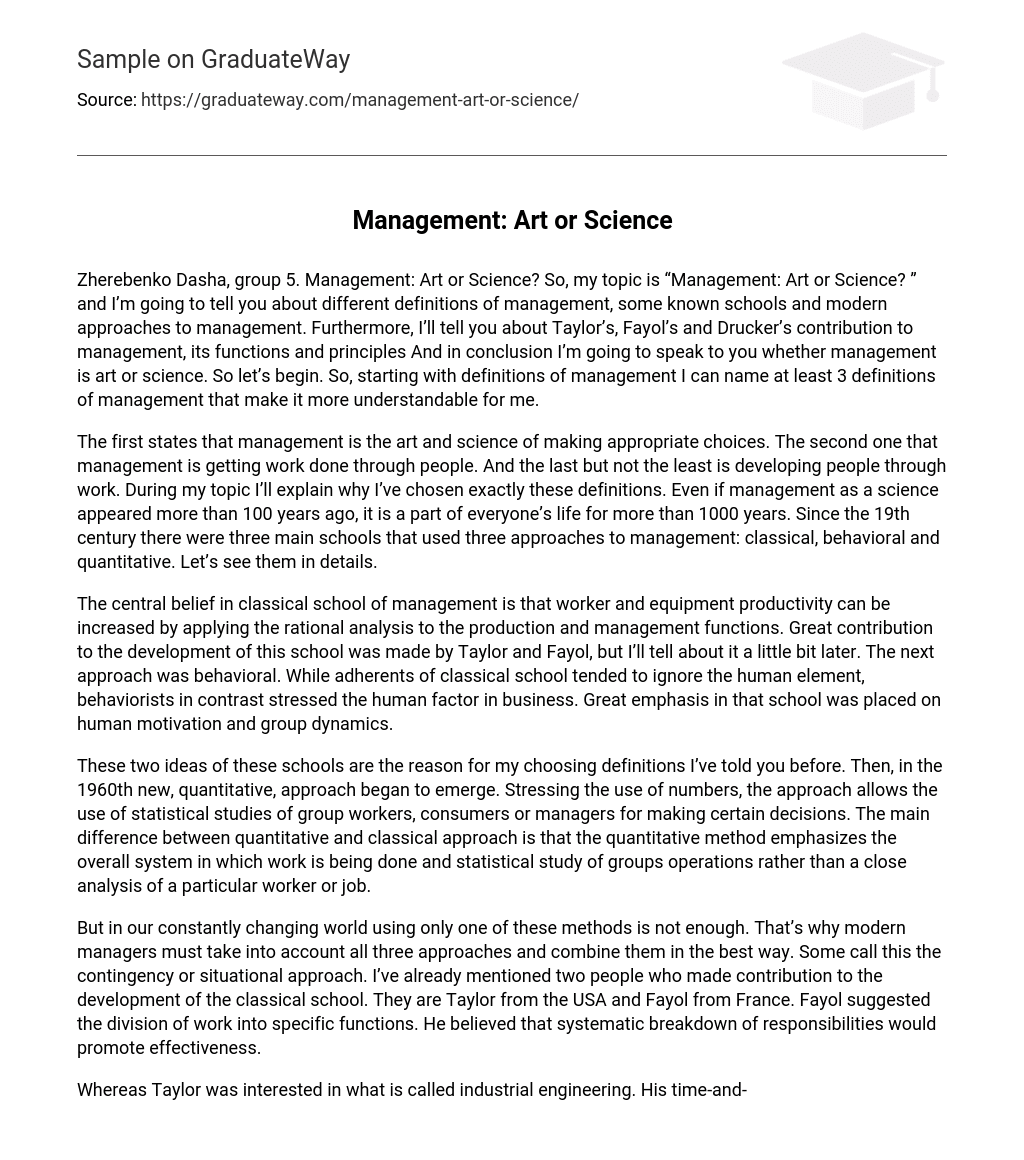So, my topic is “Management: Art or Science? ” and I’m going to tell you about different definitions of management, some known schools and modern approaches to management. Furthermore, I’ll tell you about Taylor’s, Fayol’s and Drucker’s contribution to management, its functions and principles And in conclusion I’m going to speak to you whether management is art or science. So let’s begin. So, starting with definitions of management I can name at least 3 definitions of management that make it more understandable for me.
The first states that management is the art and science of making appropriate choices. The second one that management is getting work done through people. And the last but not the least is developing people through work. During my topic I’ll explain why I’ve chosen exactly these definitions. Even if management as a science appeared more than 100 years ago, it is a part of everyone’s life for more than 1000 years. Since the 19th century there were three main schools that used three approaches to management: classical, behavioral and quantitative. Let’s see them in details.
The central belief in classical school of management is that worker and equipment productivity can be increased by applying the rational analysis to the production and management functions. Great contribution to the development of this school was made by Taylor and Fayol, but I’ll tell about it a little bit later. The next approach was behavioral. While adherents of classical school tended to ignore the human element, behaviorists in contrast stressed the human factor in business. Great emphasis in that school was placed on human motivation and group dynamics.
These two ideas of these schools are the reason for my choosing definitions I’ve told you before. Then, in the 1960th new, quantitative, approach began to emerge. Stressing the use of numbers, the approach allows the use of statistical studies of group workers, consumers or managers for making certain decisions. The main difference between quantitative and classical approach is that the quantitative method emphasizes the overall system in which work is being done and statistical study of groups operations rather than a close analysis of a particular worker or job.
But in our constantly changing world using only one of these methods is not enough. That’s why modern managers must take into account all three approaches and combine them in the best way. Some call this the contingency or situational approach. I’ve already mentioned two people who made contribution to the development of the classical school. They are Taylor from the USA and Fayol from France. Fayol suggested the division of work into specific functions. He believed that systematic breakdown of responsibilities would promote effectiveness.
Whereas Taylor was interested in what is called industrial engineering. His time-and-motion studies prepared the way for the mass production and assembly line system of today. But there is still one more person to be mentioned. It is Peter Drucker. He has the first to describe the system called “management by objectives”. Peter emphasized that an organization and its staff must have clear goals. Everyone in the organization must understand the goals they work for, know what manager expects from them and what results they are expected to achieve.
The special feature of MBO approach was that the subordinate participated with the manager in developing objectives. Most people may not realize this but when we are planning activity for the day, organize resources, follow the plan and at the end of the day compare what we’ve done to what we’ve planned we are involved in typical management functions. Management techniques of course have changed in the last 50 years but the main functions remained the same. There are five of them:
- Planning – identification of objectives, establishment of the course of action.
- Organizing – establishment of the job, division of work, putting workers together.
- Staffing – activity of attracting good people to the organization.
- Directing – helping workers to carry out plans.
- Controlling – watch how the work is performed and comparing it to the standards. To make it more understandable, imagine that the organization is the body of a person.
- Planning is its skeleton, organizing – muscles. Staffing is the blood of our “person”.
When recruiting staff you breathe life into you organization. Directing is the heart while controlling is the brain of our person. All these functions are interdependent, none of them play more or less important role. Talking about management principles I can name some of them: division of work, authority, discipline, unity of command, unity of direction, remuneration of personnel, scalar chain, and stability of tenure personnel, spirit de corps and many others. All of them are important for making company work properly.
And in the end there is only one question left: whether management is science or art? Just like our modern world management functions are becoming more complex. Using either science or only art is not enough. In short:
- Science without art is useless and dangerous.
- Art without science means stagnancy.
What else to add? In my personal view a good manager can only be born. But, as usual, there some exceptions. So, keep developing yourself, develop people around you. Develop, there is always room for improvement.





